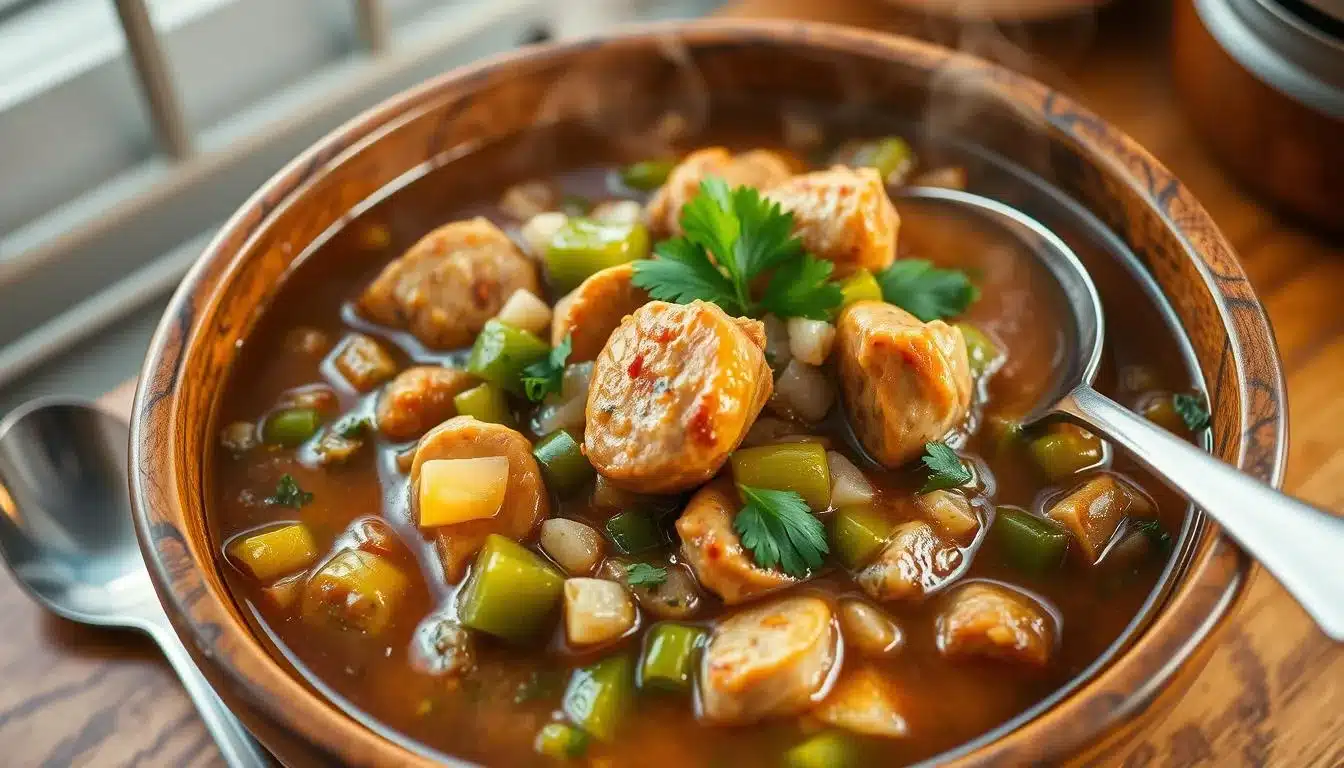The smell of chicken and sausage gumbo takes you to Louisiana. It’s where Cajun cuisine mixes cultures and cooking with passion. Every bite tells a story of family traditions in New Orleans.
Making this gumbo is more than cooking a meal. It’s connecting with a deep cultural heritage. The dish is a mix of flavors that come together beautifully.
This recipe will help you make a gumbo that truly captures Louisiana’s spirit. You’ll learn about choosing the right ingredients and making the perfect roux. It’s a way to bring Cajun cuisine into your home.
This gumbo takes 5 hours and 15 minutes to make. But it’s worth the wait. It’s a hearty dish that serves 10 and will surely get everyone wanting more.
Introduction to Authentic New Orleans Gumbo
Explore the rich world of new orleans cuisine, where gumbo is more than food. It’s a story of cultural mix and tradition. This dish shows Louisiana’s varied cooking roots, mixing African, French, Spanish, and Native American styles.
Gumbo shows Louisiana’s people’s creativity and strength. Every pot has its own story, showing local tastes and family traditions.
Origins of Creole and Cajun Gumbo
The main gumbo types come from different cultures:
- Creole Gumbo: Includes tomatoes and seafood
- Cajun Gumbo: Has darker roux and meat
“Gumbo is not just a dish, it’s a celebration of Louisiana’s culinary soul.” – Louisiana Chef
What Makes a Perfect Gumbo
A great gumbo needs a few key things:
- Rich, dark roux
- The holy trinity of vegetables
- Perfectly seasoned proteins
- Balanced spice profile
Cultural Significance in Louisiana Cuisine
Gumbo is more than food—it’s about community, history, and shared moments. It brings people together, showing the lively spirit of new orleans cuisine.
| Gumbo Type | Primary Protein | Unique Characteristics |
|---|---|---|
| Seafood Gumbo | Shrimp, Crab | Lighter, Coastal Flavor |
| Chicken & Sausage Gumbo | Chicken, Andouille | Hearty, Spicy Inland Style |
Every spoonful of gumbo is a taste of Louisiana’s soul—a journey through time and tradition.
Essential Ingredients for Chicken and Sausage Gumbo
Making a true chicken and sausage gumbo needs the right ingredients. These ingredients add depth and traditional taste to this beloved Louisiana dish. Choosing the right parts is key to a great gumbo.
The main proteins in this hearty dish are:
- Chicken (preferably thighs for richer flavor)
- Andouille sausage – typically 2 cups or 4 links
Andouille sausage adds a smoky, spicy flavor. This flavor makes the gumbo stand out. It comes from special spice mixes and smoking methods.
“In Louisiana, gumbo is more than a meal – it’s a culinary tradition passed through generations.”
Thickeners are important for the right gumbo texture. You’ll need:
- Okra – provides natural thickening and authentic texture
- Filé powder – traditional Choctaw ingredient that adds earthy undertones
| Ingredient | Quantity | Purpose |
|---|---|---|
| Andouille Sausage | 2 cups | Smoky protein base |
| Okra | 1 cup | Natural thickener |
| Filé Powder | 2 tablespoons | Flavor enhancer |
Knowing each ingredient’s role helps you make a gumbo that respects Louisiana’s rich food history.
The Art of Making the Perfect Roux
Making a perfect roux is key to Cajun cooking. It turns simple ingredients into a rich base for gumbo. Learning how to make roux can take your cooking to the next level.
A traditional roux mixes equal parts fat and flour. It’s cooked slowly to bring out deep flavors. This process needs patience and focus.
Roux Color Variations
The color of your roux changes how your dish tastes and feels. Here’s what each color means:
- White Roux: Light tan, with little flavor (2-5 minutes cooking)
- Blond Roux: Peanut butter color, with a nutty taste (5-10 minutes)
- Brown Roux: Milk chocolate color, with a rich flavor (15-30 minutes)
- Dark Brown Roux: Deep chocolate color, with a strong flavor (30-45 minutes)
Preventing Roux Burning
To avoid burnt roux, you need to stay alert. Here are some tips:
- Use a heavy-bottomed cast iron or enamel-coated pot
- Stir constantly
- Keep the heat low
- Watch for color changes
Traditional vs Modern Roux Methods
Cajun cooking has two main ways to make roux:
| Traditional Method | Modern Method |
|---|---|
| Stovetop cooking | Oven roasting |
| Constant stirring | Less hands-on monitoring |
| Oil or lard preferred | Multiple fat options |
| 45-60 minutes cooking time | 30-45 minutes cooking time |
“A perfect roux is like a culinary symphony – every ingredient plays a crucial role.” – Chef Paul Prudhomme
Getting good at roux takes time and effort. But the reward is a Cajun dish full of flavor, honoring Louisiana’s cooking traditions.
Choosing the Right Proteins
Making a great chicken and sausage gumbo begins with picking the right proteins. Your choice of protein can make or break this classic dish. Let’s explore the key ingredients that will make your gumbo taste like it’s from a restaurant.
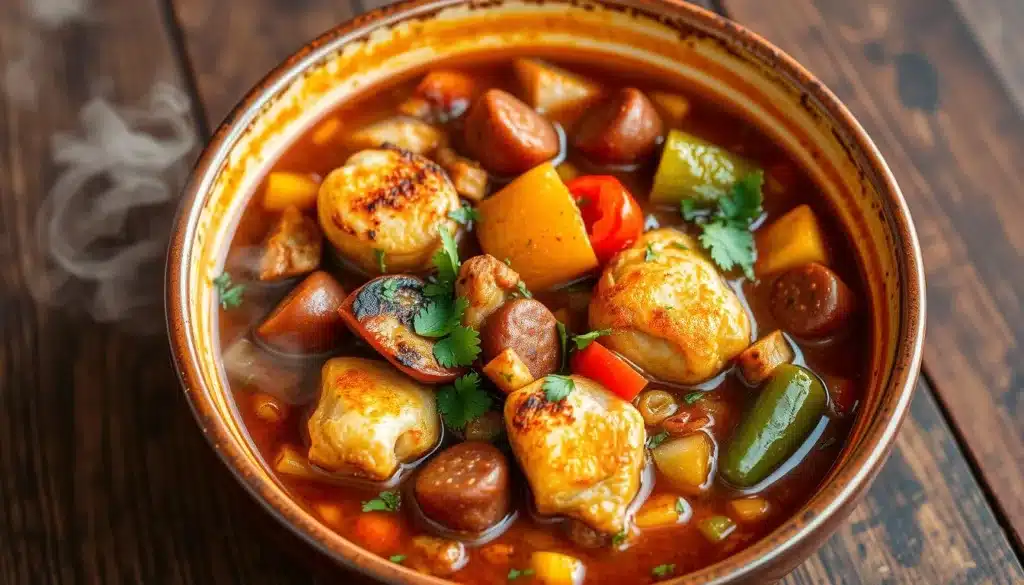
For chicken, go with boneless, skinless thighs. They offer a rich, juicy taste that breasts can’t match. To get the best results, sear the chicken for about 3 minutes on each side. This will give it a beautiful golden brown color.
“The secret to an incredible gumbo is in the proteins you choose” – Louisiana Chef Wisdom
Protein Selection Guide
- Chicken: Boneless, skinless thighs recommended
- Sausage: Andouille sausage as the traditional choice
- Cooking time: 3 minutes per side for chicken
- Searing technique: Golden brown exterior
Andouille sausage is the top pick for gumbo proteins. It adds a spicy, smoky Cajun flavor that makes your gumbo amazing. If you can’t find andouille, other smoked sausages will still give you that essential taste.
| Protein | Recommended Cut | Cooking Time |
|---|---|---|
| Chicken | Boneless, skinless thighs | 3 minutes per side |
| Sausage | Andouille | Pre-cooked, slice before adding |
Pro tip: For the best chicken and sausage gumbo, mix different proteins and let them simmer together. This way, the flavors blend, creating a rich taste that will have everyone wanting more.
The Holy Trinity: Foundation of Flavor
In creole cooking, the “holy trinity” is key. It’s a mix of vegetables that makes dishes special. This mix is at the heart of authentic cajun cuisine, adding depth and richness to your gumbo.
Proper Vegetable Preparation
Getting these veggies ready is important. You need to chop them finely for even cooking and flavor. Here are some tips:
- Use a sharp knife for clean, uniform cuts
- Aim for pieces roughly 1/4 inch in size
- Avoid large chunks that might disrupt the gumbo’s texture
Ratio and Cooking Techniques
The holy trinity ratio is 2 parts onion to 1 part each of celery and bell pepper. Sauté them on medium heat until they’re soft and slightly translucent. This releases their aromatic oils.
“The holy trinity is the soul of Louisiana cooking” – Chef Paul Prudhomme
Cooking the holy trinity takes 5-7 minutes. Keep an eye on them to avoid burning. Stir occasionally for even cooking. The aim is to get a rich flavor that’s the base of your gumbo.
Understanding Gumbo Thickeners
When making gumbo, picking the right thickener is key to getting that perfect texture. In Louisiana, two main thickeners are used: okra and filé powder. Each adds its own special touch to this classic dish.
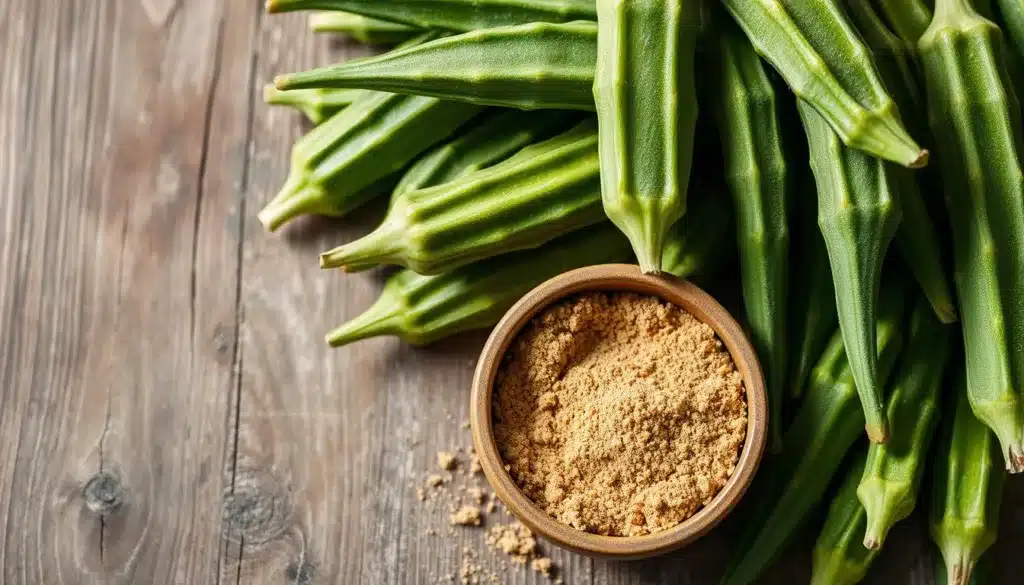
Okra is a big part of gumbo. It releases mucilage when cooked, making the gumbo thick and slightly slimy. Chefs usually add about 10 okra pods to get the right consistency.
Thickener Comparison
| Thickener | Origin | Flavor Profile | Cooking Technique |
|---|---|---|---|
| Okra | West African | Mild, slightly grassy | Added during cooking |
| Filé Powder | Native American | Sassafras-like, earthy | Sprinkled after cooking |
Filé powder, made from ground sassafras leaves, is another traditional thickener. Chefs add just 1/4 teaspoon of filé powder at the end to avoid bitterness. It adds a unique, earthy flavor that’s a hallmark of Cajun cooking.
- Okra works best when added early in the cooking process
- Filé powder should be added off heat to maintain its delicate flavor
- Some gumbo recipes use both thickeners for complex texture
“In Louisiana, the choice of thickener is more than a cooking technique—it’s a culinary tradition passed down through generations.” – Cajun Cooking Expert
The thickness of your gumbo depends on the thickener you choose. Whether you like the slimy texture of okra or the sassafras flavor of filé powder, both add to gumbo’s rich taste. This makes gumbo a favorite in the South.
Seasoning and Spice Blend Guide
Creating the perfect seasoning is key in cajun cuisine. The right spice blend turns a simple gumbo into a memorable dish. It captures the heart of creole cooking.
Making a true spice mix means knowing the balance of flavors. This balance is what makes Louisiana’s food so special.
Creating Your Own Cajun Spice Mix
Your homemade Cajun seasoning needs these key ingredients:
- Paprika (gives a deep red color and mild heat)
- Garlic powder (adds strong flavor)
- Onion powder (boosts savory taste)
- Dried oregano (adds herbal depth)
- Dried thyme (brings earthy notes)
- Cayenne pepper (gives Louisiana’s famous heat)
Balancing Heat and Flavor
The secret to a great spice blend is in the mix. Use these ratios as a starting point:
| Ingredient | Quantity | Purpose |
|---|---|---|
| Paprika | 2 tablespoons | Base flavor and color |
| Cayenne | 1 teaspoon | Heat control |
| Garlic Powder | 1 tablespoon | Depth of flavor |
| Dried Herbs | 1 teaspoon each | Aromatic complexity |
“In cajun cuisine, seasoning is an art form that speaks to the soul of Louisiana’s culinary heritage.” – Louisiana Chef Tradition
Adjust the cayenne pepper to your liking. Start conservatively. You can always add more heat, but you can’t take it away once it’s mixed.
Step-by-Step Cooking Process
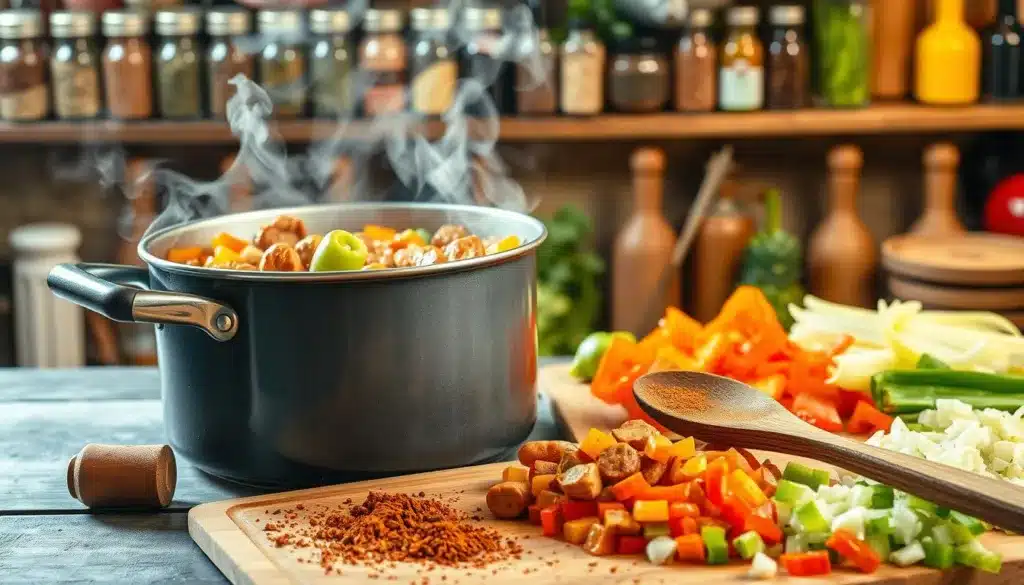
Making a real chicken and sausage gumbo takes time and skill. It starts with making the base of this beloved Louisiana dish.
“A great gumbo is like a delicious symphony of flavors, where each ingredient plays a crucial role.” – Cajun Cooking Tradition
Here are the key steps to make your gumbo just right:
- Roux Preparation
- Heat 1 cup canola oil in a heavy-bottomed pot
- Slowly add 1 cup all-purpose flour while whisking
- Keep stirring at 350°F for about 40-60 minutes
- It should turn a deep chocolate-brown
- Vegetable Sautéing
- Put in diced onions, bell peppers, and celery
- Cook for 10 minutes until they’re soft
- Add minced garlic
- Protein Integration
- Cook 2 pounds andouille sausage until browned
- Add 4 pounds of chicken pieces
- Make sure the meat is fully cooked
- Liquid and Seasoning
- Pour in 8-10 cups of chicken stock
- Add bay leaves and thyme
- Season with Worcestershire sauce
- Add hot sauce to taste
The last step is to simmer your gumbo for 1-2 hours. This slow cooking lets the flavors mix well. It makes a rich, complex dish that truly captures the spirit of Creole cuisine.
Traditional Cooking Equipment and Tools
Making a real gumbo is more than just using the right ingredients. The tools you use in your kitchen are key to getting the true taste of New Orleans. The right equipment can make your gumbo a hit.
- Heavy-bottomed cast iron pot or Dutch oven
- Wooden spoon or specialized gumbo paddle
- Long-handled whisk
- Measuring cups and spoons
- Sharp chef’s knife
The heavy-bottomed pot is essential. It keeps the heat even and stops your roux from burning. A cast iron pot is perfect because it holds heat well and adds deep flavors.
“A good pot is like a trusted friend in the kitchen – it never lets you down.” – New Orleans Chef Tradition
| Equipment | Purpose in Gumbo Preparation | Recommended Material |
|---|---|---|
| Dutch Oven | Roux Making and Simmering | Cast Iron |
| Wooden Spoon | Stirring Roux | Hardwood |
| Whisk | Blending Ingredients | Stainless Steel |
Even today, you can use modern tools alongside traditional ones. A wooden gumbo paddle is still the best, but silicone spatulas are great for easier cooking in New Orleans.
Tips for Achieving Authentic Gumbo Texture
Making the perfect chicken and sausage gumbo is all about the texture. It should be rich, complex, and just right in consistency. It can’t be too thin or too thick.
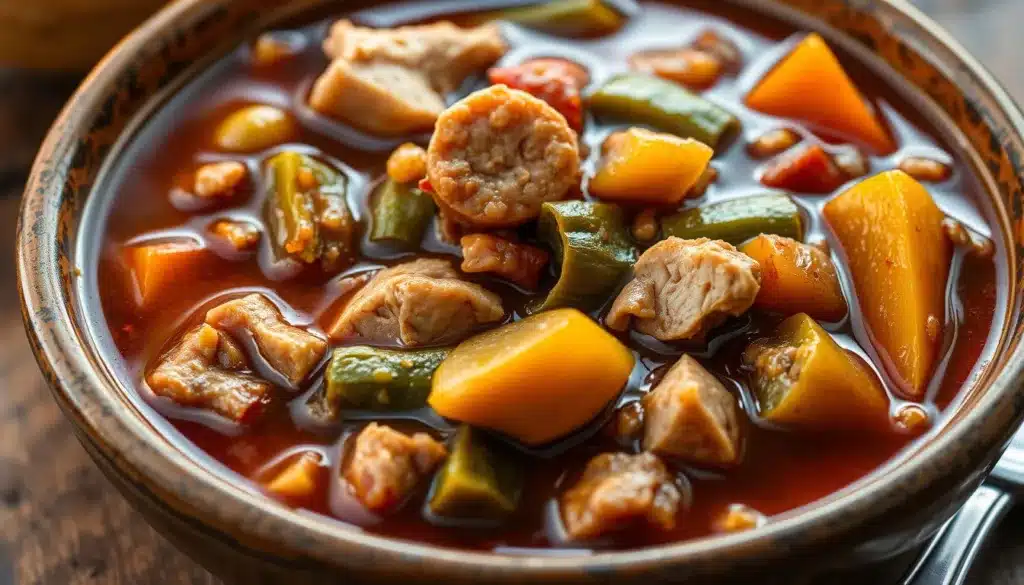
The perfect gumbo is a mix of soup and stew. To get it right, pay close attention to a few important steps.
Perfect Consistency Guidelines
Here are some key tips for the right gumbo texture:
- Aim for a thickness that coats the back of a spoon
- Use a 1:1 ratio of flour to oil when making roux
- Simmer for at least 1-2 hours to develop depth
- Adjust liquid content gradually
Troubleshooting Common Texture Issues
If your gumbo isn’t right, don’t worry. Here are fixes for common problems:
| Issue | Solution |
|---|---|
| Too Thin | Increase roux or simmer longer |
| Too Thick | Add chicken broth incrementally |
| Burnt Roux | Start over – dark brown, not black |
“The secret to perfect gumbo is patience and practice.” – Louisiana Chef
Remember, practice makes perfect when making chicken and sausage gumbo. Each try will teach you more about controlling texture.
Pro tip: Let your gumbo rest for 15-20 minutes after cooking. This lets flavors mix and the texture settle, making it more authentic.
Serving and Presentation Techniques
Presenting your gumbo is an art form in New Orleans cuisine. It’s more than just putting food in a bowl. The right way to serve it can make your meal better and show off Louisiana’s rich cooking traditions.
Here are some key presentation tips for serving gumbo:
- Always serve over a bed of fluffy white rice
- Garnish with fresh chopped green onions
- Sprinkle finely chopped parsley for color
- Use wide, shallow bowls to highlight the gumbo’s texture
The perfect serving temperature for gumbo is hot but not too hot. Let it rest for a few minutes after cooking. This helps the flavors meld together.
“A perfectly served gumbo tells a story of tradition, culture, and culinary passion.” – Louisiana Chef Wisdom
For a professional look, try these plating techniques:
- Center the rice in the bowl
- Carefully ladle gumbo around the rice
- Create a small mound of rice visible through the broth
- Sprinkle herbs delicately on top
Your gumbo serving can turn a simple meal into a memorable experience. It captures the heart of New Orleans cuisine.
Storage and Reheating Methods
Keeping your homemade chicken and sausage gumbo fresh is key. Knowing how to store and reheat it right is crucial. This way, you keep its taste amazing and stay safe from foodborne illnesses.
Refrigeration Guidelines
Store your gumbo in the fridge for 3-4 days. Here are some important tips:
- Use airtight, leak-proof containers
- Cool the gumbo completely before refrigerating
- Store at or below 40°F (4°C)
- Divide large batches into smaller portions for faster cooling
Freezing Your Gumbo
Freezing your gumbo makes it last longer. Freezing can keep your gumbo fresh for up to 6 months.
| Storage Method | Duration | Recommended Container |
|---|---|---|
| Refrigerator | 3-4 days | Airtight glass or BPA-free plastic |
| Freezer | 4-6 months | Freezer-safe container |
Reheating Best Practices
Follow these steps to reheat your gumbo:
- Thaw frozen gumbo overnight in the refrigerator
- Reheat slowly on the stovetop
- Stir occasionally to prevent burning
- Ensure internal temperature reaches 165°F (74°C)
“Properly stored gumbo can taste even better the next day as flavors continue to develop!” – Cajun Cooking Wisdom
Always check for spoilage signs before eating stored gumbo. Look for odd smells, mold, or texture changes. By storing and reheating your gumbo correctly, you’ll enjoy it safely and deliciously.
Wine and Beverage Pairings
Finding the perfect drink to go with chicken and sausage gumbo can make your meal better. The rich, spicy taste of gumbo needs a drink that balances and adds to its flavor.
- Low-tannin red wines like Pinot Noir and Zinfandel
- Off-dry white wines such as Riesling and Gewurztraminer
- Sparkling wines like Prosecco for seafood gumbo variations
Want to know the best wines for your gumbo? Here are some top picks:
| Wine Type | Price Range | Alcohol Content | Gumbo Pairing |
|---|---|---|---|
| Nik. Weis Urban Riesling | $15 | 10% | Chicken Gumbo |
| Flaco Tempranillo | $10 | 13.5% | Seafood Gumbo |
| Chateau Bonnet Rose | $12 | 13% | Spicy Gumbo |
Pro tip: For spicier gumbo, pick wines that are a bit sweeter. Riesling and Gewurztraminer are great for new Orleans cuisine.
“The right wine doesn’t just accompany a meal; it transforms the entire dining experience.” – Culinary Expert
Wine isn’t the only choice. Wheat beers or a Bloody Mary also pair well with gumbo’s bold flavors.
Recipe Variations and Adaptations
Gumbo offers endless possibilities for creative cooks. You can change your classic chicken and sausage gumbo with simple swaps. This traditional Louisiana dish is very adaptable.
Seafood Gumbo Possibilities
Seafood gumbo adds a fun twist to the classic recipe. You can add different seafood to make it taste even better:
- Shrimp: Add 1 ½ pounds of fresh or frozen shrimp
- Crab meat: Mix in lump or claw crab meat for richness
- Oysters: Introduce fresh oysters for a briny taste
Vegetable Alternatives and Customizations
You can try different vegetables instead of the classic “holy trinity”:
| Vegetable Category | Traditional Option | Alternative Suggestion |
|---|---|---|
| Onions | White onions | Red onions, shallots |
| Bell Peppers | Green peppers | Red or yellow peppers |
| Celery | Standard celery | Fennel, bok choy |
“Gumbo is a dish said to have as many recipes as there are cooks” – Louisiana Culinary Tradition
While trying new things is great, keep the dish’s core flavors in mind. The roux, protein, and veggies must balance well for a true gumbo taste.
Health Benefits and Nutritional Information
Your favorite chicken and sausage gumbo is more than tasty—it’s full of good stuff for your body. It’s a meal that’s both filling and healthy, thanks to careful preparation.
- Protein: 31g – helps build and fix muscles
- Calories: 677 kcal – gives you energy for the day
- Total Fat: 50g – has important nutrients
- Carbohydrates: 22g – gives quick energy
The veggies in gumbo add key nutrients. The “holy trinity” of onions, bell peppers, and celery bring vitamins and minerals that boost health.
“Gumbo is more than a meal—it’s a nutritional journey through Louisiana’s culinary landscape.” – Chef Marie Leblanc
To make your chicken and sausage gumbo even better, try these tips:
- Choose leaner meats
- Add more veggies
- Watch your portion sizes
- Make your own stock to cut down on salt
While it’s tempting to eat a lot, remember to eat in moderation. Enjoy your gumbo as part of a healthy diet, savoring its taste and health benefits.
Conclusion
Your journey into chicken and sausage gumbo is more than a recipe. It’s a dive into New Orleans’ culinary soul. This dish is a mix of Creole cooking, showing the blend of cultures and creativity.
Every gumbo you make keeps a tradition alive for generations. It takes patience, from making the dark roux to picking the right sausage. Your kitchen becomes a doorway to Louisiana’s rich food heritage, connecting you to its diverse cultures.
Whether you’re cooking for 6-8 or meal prepping, gumbo is an experience. Leftovers stay tasty for 3-5 days in the fridge or up to 4-6 months frozen. Feel free to add your own twist to this New Orleans classic.
As you delve deeper into cajun cuisine, let each gumbo be a celebration of flavors, history, and Louisiana’s unique food traditions.
FAQ
What is the difference between Cajun and Creole gumbo?
Cajun gumbo uses a darker roux and focuses on rustic cooking. Creole gumbo, on the other hand, includes tomatoes and more ingredients, showing the urban New Orleans style. Both styles use roux, the “holy trinity,” and rich flavors.
How long does it take to make an authentic chicken and sausage gumbo?
Making traditional gumbo takes 2-4 hours. Roux-making alone takes 30-45 minutes. The slow cooking lets flavors blend, creating a deep taste.
Can I make gumbo without okra or filé powder?
Yes, you can make gumbo without okra or filé powder. Dark roux thickens the gumbo well. If missing okra, cook the roux longer or use filé powder for thickening and flavor.
What type of sausage works best in gumbo?
Andouille sausage is the best choice for Cajun gumbo, offering smoky, spicy flavor. If andouille is not available, kielbana or chorizo can be used, though the taste will differ.
How do I prevent burning my roux?
Use a heavy-bottomed pot, stir constantly, and cook on medium-low heat to avoid burning. Some prefer oven cooking for even heat. Watch for color changes to avoid bitter taste.
Is gumbo a healthy dish?
Traditional gumbo is not low-calorie but offers nutritional benefits. It’s rich in protein and vegetables. For a healthier version, use leaner meats and add more veggies.
How long can I store leftover gumbo?
Store gumbo in an airtight container in the fridge for 3-4 days or freeze for 3 months. It often tastes better the next day as flavors develop.
What’s the best way to serve gumbo?
Serve gumbo over white rice with parsley or green onions. Add hot sauce or file powder at the table. Crusty French bread is a classic side dish.
If you’re a fan of experimenting with flavors and trying new recipes, we’ve got some must-tries for you. Check out these delicious options below:”
- Peach Schnapps Recipes: Discover refreshing drink ideas that are perfect for any occasion.
- Vanilla Nut Granola Recipe: A wholesome and crunchy snack to enjoy anytime.
- Chocolate Gravy Recipe: Indulge in a creamy, rich topping perfect for breakfast or dessert.
- Craving more delicious recipes? Visit our Facebook page for daily inspiration, tips, and mouthwatering ideas!

Chicken and Sausage Gumbo
Ingredients
- 2 cups Andouille Sausage
- 1 cup Okra
- 2 tablespoons Filé Powder
- 4 pounds Chicken Thighs boneless and skinless
- 1 cup Canola Oil
- 1 cup All-Purpose Flour
- 2 cups Diced Onions
- 1 cup Diced Bell Peppers
- 1 cup Diced Celery
- 4 cloves Minced Garlic
- 8-10 cups Chicken Stock
- 2-3 Bay Leaves
- 2 teaspoons Dried Thyme
- Hot Sauce to taste
Instructions
- Prepare the roux: Heat canola oil in a heavy-bottomed pot, whisk in all-purpose flour, and cook at 350°F for 40-60 minutes until deep chocolate brown.
- Add diced onions, bell peppers, and celery, sauté for 10 minutes until soft.
- Integrate the andouille sausage and chicken, ensuring the meat is browned and fully cooked.
- Pour in chicken stock, bay leaves, and thyme. Season with Worcestershire sauce and hot sauce to taste.
- Simmer for 1-2 hours, allowing flavors to meld and deepen.

